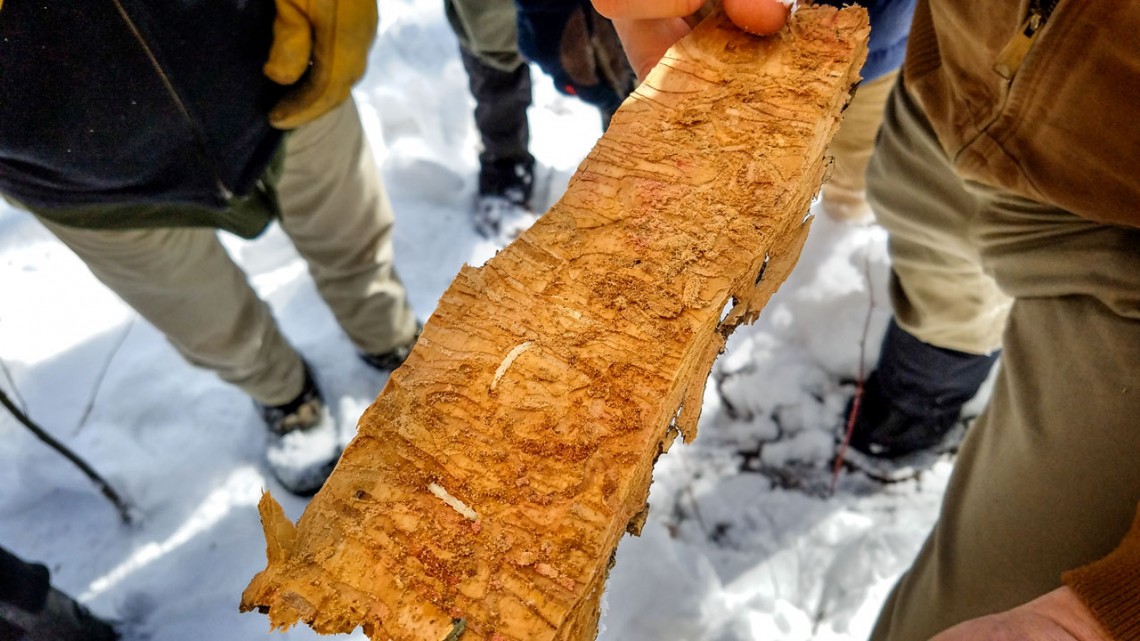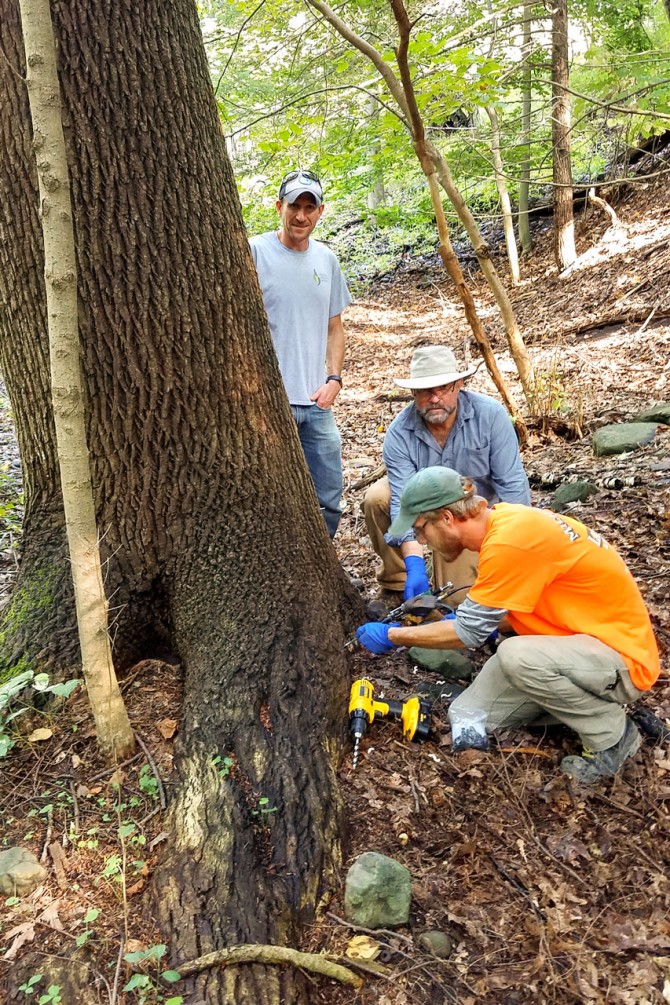
Emerald ash borer larvae and galleries discovered under the bark of an ash tree at Arnot Forest, March 2018, marking Tompkins County’s first documented emerald ash borer occurrence.
Cornell removing ash trees, as replanting effort launches
By Krishna Ramanujan
Cornell will be removing more than 1,700 of its ash trees infested by devastating emerald ash borer insects, mostly between January and March 2021, to reduce potential harm to people and property. At the same time, an initiative has been developed to replant trees.
The university will be sending letters in the coming weeks to notify local municipalities and neighbors of the ash abatements.
The latest removals are part of phases 2 and 3 of Cornell’s Emerald Ash Borer Action Plan to manage thousands of on- and off-campus ash trees that have succumbed to the invasive Asian beetle. The plan was created through input from members of Facilities and Campus Services; Cornell Botanic Gardens; the Grounds Department; the College of Agriculture and Life Sciences; Community Relations; Cornell Risk Management; and the Cornell Real Estate Department.
The emerald ash borer (EAB) has ravaged ash trees in every state in the country and was first detected in Tompkins County, in Cornell’s Arnot Teaching and Research Forest, in 2018, though the beetles had likely been in the area for a few years prior. The beetle’s larvae feed on the inner bark of ash trees, disrupting water and nutrient flow, and are capable of killing a tree in three to four years.
Once an adult tree dies, some as tall as 80 feet, it eventually fails, potentially posing a safety risk.
“This is a safety issue with trees that are dying or near death, and will eventually fall, so we are going to need to take them down in order to limit concerns about public safety and property damage,” said Todd Bittner, director of natural areas for Cornell Botanic Gardens.
Phase 1 of the EAB Action Plan began last year and continued through 2020. Cornell staff treated 172 high-value trees with pesticides, an expensive protocol that must be repeated every two to three years. These treated ash trees were in the Arts, Agriculture and Engineering quads; in Cornell natural areas; and accessioned collection trees from across North America and Europe within the Cornell Botanic Gardens’ F.R. Newman Arboretum. Additionally, 430 trees were removed over the last two years from Sapsucker Woods, Varna, main campus and limited on-campus natural areas.
University experts inventoried over 3,800 ash trees to date – mostly white ash – across Cornell’s on- and off-campus lands and developed a plan to address them.
In phase 2, from January to mid-March 2021, contractors hired by the university will remove infested off-campus trees in high-priority areas that are adjacent to private property, including the Ithaca Tompkins Regional Airport, Varna, Ellis Hollow and Baker Hill.
Also, as part of phase 2, the university will be posting three types of signs at entrances to University-owned trails otherwise open to the public:
- to inform people about why trees are being cut;
- to close trails in limited areas because they contain trees that are too costly and/or difficult to remove; and
- to make users aware of potential risks in less-frequented trails on and off campus, including in the Botanic Gardens and Natural Areas, where trees will be left alone but could pose a risk when they die.
“The signs are intended to inform the public of the University’s overall plans, and to make them aware that in order to maintain lands in support of Cornell’s academic and research mission, some affected trees will be left uncut,” Bittner said.
Concurrently, phase 3 of the EAB Action Plan will take place in campus natural areas – including land around Cascadilla and Fall Creek gorges, Beebe Lake, Mann Library Slope, Palmer Woods, Fall Creek Natural Area, the Mundy Wildflower Garden and portions of the F.R. Newman Arboretum – in two stages: Between January and March 2021, a total of 505 trees will be removed by contractors; and now through March 2021, up to 300 trees will be taken down by university staff. Future phases will be required to address all identified high-risk trees.
“The work will be highly visible and will, unfortunately, create significant changes on the campus landscape for decades,” Bittner said.
The fate of each tree is based on risk criteria outlined by the International Society of Arboriculture Tree Risk Assessment standards. Trees are prioritized based on the likelihood of a tree or branches falling (which eventually happens for every EAB-infested tree); whether there are people, vehicles, buildings and other property below; and how often people or cars pass beneath a tree, and the consequences if one is struck.
Impact consequences were prioritized for each tree, from highest to lowest risk, due to high pedestrian traffic, structures, medium pedestrian traffic, parking lots, roads and low pedestrian traffic.
Cornell arborists will be surveying for trees that survive the EAB outbreaks, in hopes of breeding resistant varieties.
Members of the public may also be on the lookout for “blonding” in ash trees – places on the trunks where woodpeckers feeding on EAB larvae have stripped the bark.
Cornell Botanic Gardens is in the process of launching a significant fundraising effort, the Future Forests Initiative, to replant trees that will be more resilient to future climate changes and to offset the loss of ash trees. Interested people may make donations to Cornell Botanic Gardens. Donations have already allowed the botanic gardens to plant 200 new trees in 2020.
Media Contact
Get Cornell news delivered right to your inbox.
Subscribe

